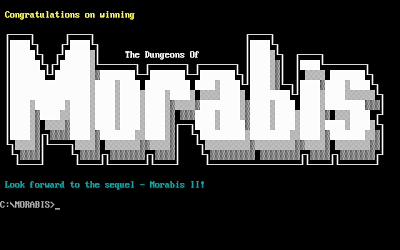From The CRPG Addict
Morabis I: The Dungeons of Morabis
United States
Independently developed and released as shareware
Several versions released for DOS between 1991 and 1992
Date Started: 2 May 2020
Date Ended: 10 May 2020
Total Hours: 11
Difficulty: Moderate-Hard (3.5/5)
Final Rating: (to come later)
Ranking at time of posting: (to come later)
Difficulty: Moderate-Hard (3.5/5)
Final Rating: (to come later)
Ranking at time of posting: (to come later)
Summary: A roguelite, Morabis blends Rogue-style gameplay with an Ultima-esque attention to map design. There are some interesting new features added, such as a targeting cursor for missile weapons and the ability to see and dodge incoming missiles and magic blasts. Overall, though, most of Morabis‘s changes from the traditional roguelike template make it longer and more frustrating than the typical roguelike. Bugs, misspellings, and version inconsistencies also hurt enjoyment.
*****
The second half of Morabis preceded much like the first half, except that with more difficult levels some of the game’s problems became magnified. The chief issue with the game is the level scaling that goes on as you descend further into the dungeon. Creatures increase in attack power and accuracy in proportion to the level you’re on, such that you never seem to “develop” as a character. Meanwhile, you’re constantly having to chase down new, improved weapons and armor to account for the greater monster power. Because their accuracy also improves, you spend a lot of time fleeing combat and waiting to heal before re-engaging. You spend an awful lot of time gingerly standing in doorways in this game, as if an earthquake is always about to hit.
The search issue never went away, but it was magnified on some levels where large portions were initially occluded. I was also a bit irked by the sheer number of ways the author found for enemies to paralyze or confuse me. I swear that every enemy, even ones who had no special powers on earlier levels, were capable of one or the other during the last 10. Between enemies and traps, I couldn’t walk more than five steps at a time without being told I couldn’t move. Half the time, I had no idea why. And at least half my deaths were caused by walking the wrong way into lava when I was confused.
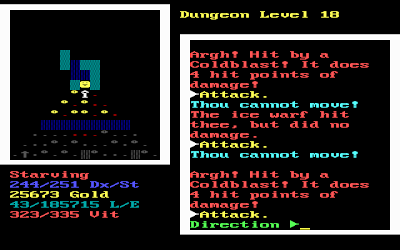 |
| Starving and unable to move sometimes feels like the default state in this game. |
Food was also a sporadic problem. It was quite literally feast or famine. There was one period where I had to save-scum for about half an hour until I got a couple enemies to drop food when I killed them; otherwise, I starved to death before I could get anywhere. Nothing is more frustrating than finally finding food and having it turn out to be rotten or poisonous, but of course Rogue had that, too.
The best times were when, for a brief time, I had a magic item capable of alleviating some of the game’s more powerful annoyances. I enjoyed a Ring of Trap Avoidance for a few levels. A Ring of Slow Digestion was also a godsend. I found a Scroll of Nutrition at one point with about 15 charges. That was a load off. There are supposedly Rings of Lava Walking and Rings of Avoid Paralysis in the game, but I never found either. Anyway, rings don’t last forever in Morabis, so at best they offer temporary reprieve.
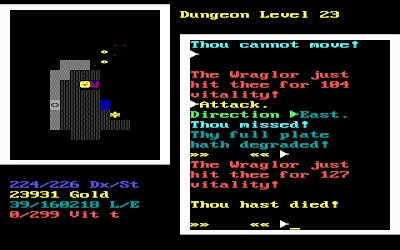 |
| A “wraglor” degrades my armor just before he kills me. |
As I descended, I started to appreciate the author’s approach to level design a bit more. I corresponded with Michael Höenie, and he sent me some of the game maps as examples. (There’s no way to view the entire map of a level from within the game, unfortunately). Using handcrafted levels instead of randomly-generated ones allowed him to do some fun things with the terrain. Some levels suggested rough-hewn natural caverns, while others suggested fortresses or jail cell blocks. Level 24 is basically one long, thin causeway over lava. The final dungeon level in particular, Castle Morabis, had an almost Ultima quality in the map design. It’s just too bad that you can’t appreciate it from within the game. The 81 x 81 level sizes are a bit large, too.
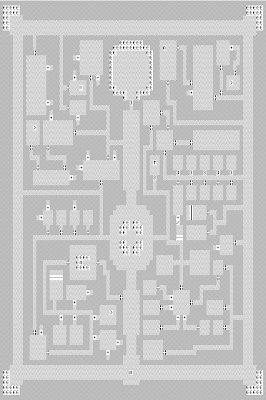 |
| The final dungeon level, courtesy of the author. |
Every fifth level features a mini-boss guarding the way down: Fennel the Fire Lark on Level 5, Jahaÿ the Gobnor on Level 10, Ñehnor the hobnorlin on Level 15, and Nimlatch the Dragon on Level 20. They had more hit points than others of their class but otherwise weren’t terribly difficult.
There’s an odd special encounter on Level 18 with a roomful of unicorns. They attack you, but if you attack them, the game says, “Oh! Thou mustn’t hurt a Unicorn!” (“Thou-speak” is another borrowing from the Ultima series.) What you’re supposed to do, according to Höenie’s web site, is find some grass and drop it in front of them, then they give you a key necessary for the final dungeon level. I didn’t read this until I’d left Level 18 well behind me. The encounter isn’t really fair. Nowhere else in the game do you interact with creatures this way, and there’s no particular reason to think that the unicorns would want grass.
 |
| I can’t attack the unicorns, but they have no such compunction. |
As for keys, you find copious numbers of them on the way down–brass, pewter, tin, copper, steel, platinum, beryllium . . . so many that you run out of inventory space if you try to carry them all. They’re mostly unused until the final level, where it appears that every other door wants a different one. At least two doors require the one that the unicorns drop, and I didn’t have that. Rather than waste hours going back to Level 18, I hex-edited my saved games to jump across the door.
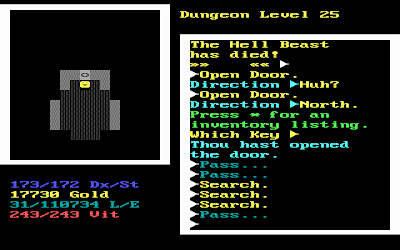 |
| Opening one of the final doors with a key. |
Level 25 is shaped like a castle. You start in the lower-center, and if you just move north from there, you come to the chambers of the demon lord. As I approached his chamber and he taunted me, the game called him “Satu’Javu,” but when I actually fought him, he was named “Satu’Nävas. Either way, I killed him in a few blows on my first try.
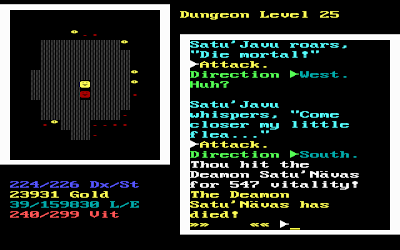 |
| The demon has two different names depending on whether he’s taunting me or dying by my sword. |
The Amulet of Sae’gore is found in a nearby chamber, guarded by a couple of “zelthorns.” I had hoped that when I killed the demon and picked up the amulet, the game would automatically end, but no, just like Rogue, I had to make my way back up to the surface. Also like Rogue, the game preserves the original difficulty level of the game levels as you ascend, meaning that it’s really no challenge once you get out of the bottom few.
Uninterested in spending this kind of time, I made use of an exploit. When the character dies on a level and you reload, the game always reloads you on the up-staircase of that level. Thus, through a boring but faster process of die-reload-up, I made my way to Level 1 and out of the dungeon. There, I got the concluding message:
Congratulations!! You found the amulet and escaped with your life! Unfortunately, Lord Devnon, seeing your triumph, has escaped. Fleeing with only his life, he has returned to Valkner’s Keep. Peace will now reign in the land of Croon, at least for a little while . . .
 |
| Winning the game. |
This brief paragraph manages to confuse the story even more. The story in the manual is titled “your quest for the Amulet of Sae’gore” but doesn’t even mention the Amulet of Sae’gore, and is instead about the new king attempting to defeat Lord Devenon by finding the Scarlette Sword and the Armor of Power. Nether Satu’Javu, Satu’Nävas, the land of Croon, nor Valkner’s Keep are mentioned in the manual backstory, either.
On a GIMLET, Morabis I gets:
- 1 point for the game world. What would normally be 2 is lowered by the tangled backstory.
- 1 point for character creation and development. Every character is the same generic adventurer, and the level scaling problem makes development feel futile at times.
- 0 points for no NPC interaction, although Höenie had plans for them in the next version.
 |
| Fighting enemies while walking on a thin bridge over lava. One wrong step means death. |
- 3 points for encounters and foes. The enemies were satisfyingly variant in their special abilities, although not to the level of NetHack or even the original Rogue. I liked the mini-bosses at regular intervals.
- 2 points for magic and combat. The game features fewer tactics than traditional roguelikes, in particular lacking any spellcasting system. There’s also no speed differential and fewer useful items to employ.
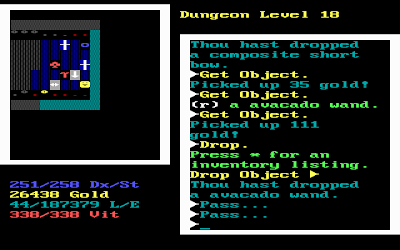 |
| Sorting through a treasure pile after killing a dragon. I’m not sure I want to know what an “avocado wand” is. |
- 3 points for equipment. It has a roguelike’s variety but not quite as much variety as most. I found that wands were almost useless. There’s only one main armor type–no helms, gauntlets, boots, and the like. But what really killed this category for me was the lack of consistency between objects of the same description. Part of the challenge of roguelikes has always been discerning, through various clues and testing, what colors go with what potions and what descriptions go with what rings, scrolls, and wands. The difficulty of lower levels is eased slightly by the fact that you’re no longer wasting time probing each new item for its likely properties. In Morabis, with colors and descriptions assigned randomly to each individual object, that process never ends. The only mitigating factor is that Scrolls of Identification are relatively common.
- 0 points for no economy. You can collect gold, but there’s nowhere to spend it, nor does it count towards any score.
- 2 points for a main quest.
 |
| Finding the Amulet on Level 25. |
- 2 points for graphics, sound, and interface. Pretty much any decent roguelike gets a 3 for its utility of graphics and its keyboard interface. I subtracted a point for the searching, the lack of an automap, and frequent artifact issues with the interface.
- 2 points for gameplay. For the most part, I found the levels too big and the annoyances outweighing the satisfying moments. There’s no real replayability inherent in it.
That gives us a final score of 16, from which I subtract 2 points for bugs and needless confusion in the story and instructions. The confusion comes from Höenie being between versions when he gave up, the manual having been edited ahead of the game itself.
In e-mails to me, Höenie said that Morabis started in 1985 (when Höenie was 16) as a text-based BBS game. Höenie had been a dungeon master on a server for Scepter of Goth (1978), and when Scepter was deprecated, he set out to create a similar game.
After he got some experience with offline games–principally, Rogue, Tunnels of Doom, and Ultimas I-III–Höenie began working on his own single-player roguelike, blended with elements from Ultima like the inability to see around walls. He originally called it Morabis II, but it soon became just Morabis. After he released it, Höenie got about halfway through Morabis II: The Quest for the Staff of Yar’Bore–which would have included a level editor, spells, and NPCs with dialogue and transaction options–but ultimately life intervened and he never finished it.
Höenie maintains a web page devoted to Morabis, on which you can find some instructions for further cheating the game by adding items.
The next game is supposed to be Moraff’s Dungeons (1993), the first time that I move prematurely forward in my chronological order, and I confess that despite how well I argued for this new development a few months ago, I’m now having second thoughts.
Original URL: http://crpgaddict.blogspot.com/2020/05/morabis-i-won-with-summary-and-rating_12.html

